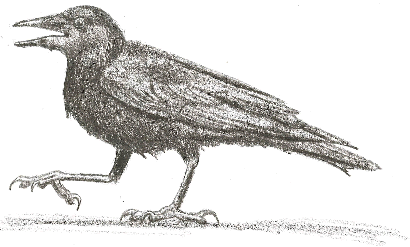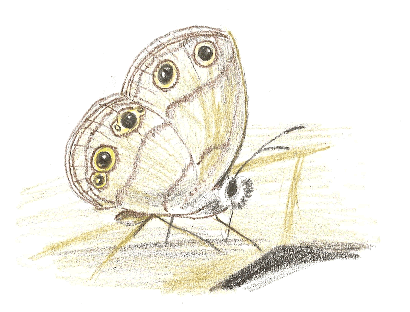the Lone Star version, Part II. (original) (raw)
First published in English in 1780, this traditional French medley glorifies the 12 days between Christmas proper and the Feast of the Epiphany on January 6. American fans pay homage to Milwaukee�s Emily Brown who imported the tune in 1910 to brighten a Wisconsin Christmas extravaganza. The lyrics of the traditional carol have been variously interpreted as religious symbolism, examples of the bounties of each month of the calendar year, and/or random accumulations of pastoral images. With the academic jury still out on the �true� meaning of the Twelve Days of Christmas, I�ve decided to reinterpret the song with a bit of Texasflare:
�Four calling birds��

American crow playing
Drawing by Anton Wroblewski
Few Texas calling birds have more to say than the American crow (Corvus brachyrhynchos). Their diverse vocabulary of caws, rattles, coos, gargles, growls, and noises that defy easy definition demonstrate symbolism, rules of syntax, creativity, the ability to count, individual recognition, and even cultural variation. Much like our own, crows� advanced language and reasoning capabilities most likely developed as a result of their complex social systems. Maneuvering in close family units (children from one year may help in raising the next season�s little ones) as well as large wintertime roosts and foraging murders requires the ability to communicate everything from intimate cues between lovers to group warnings about potential threats.
By arranging a host of sounds in differing patterns of duration, harmony, vibrato, pitch, and/or repetition in combination with unique body language cues, these corvids (a family that also encompasses ravens and jays) are able to assemble massive scolding, diving flocks to harass and dissuade predators as easily as they can quickly dissolve aggregates into fleeing squadrons, avoiding any impending dangers. The perceived seriousness of the threat along with the type of predator encountered is expressed by different �caw�s and �ko�s and the intensity with which each vocalization is projected. Similarly, crows can vary types of calls to give them specific meanings in the context of begging displays, territorial battles, courting rituals, and social murmurings among family members. Replications and fluctuations of corvid messages indicate that the intelligent birds can count to at least six and adhere to structural assemblies of sounds like the words constructing human sentences. These ebony wordsmiths can even call each other by name: distinctive voices enable individual recognition and one crow may imitate the intonation of another to gain the bird�s attention.
The complex languages of American crows show evidence of diverging dialects, supporting arguments for the evolution of culture in the non-human animal world. Unique noises and vocalization types are often consistent within one group of these brainy birds, but completely different in other crow assemblies. These �dialects� are so definitive that they can be used to recognize the member(s) of one group within another group or mishmash of groups. When a new feathered orator joins the roster of a pre-existing tribe, the adherent learns the local dialect through mimicry, allowing the dialect to carry on through multiple generations and troop influxes. The mimicking nature of crows is most apparent in the case of many captive and pet corvids that learn to speak commonly uttered human phrases and/or perfectly replicate the noises made by pets and inanimate objects. I�m sure somewhere out there, a crow has even learned to belt out the lyrics of the Twelve Days of Christmas, albeit with her own distinctive cawing flair.
�Five gold(en) rings��

Five golden rings of the Little wood-satyr
Drawing by Anton Wroblewski
What more gorgeous golden rings to celebrate than those gracing the delicate wings of the little wood-satyr (Megisto cymela)? Flitting through the dappled sunspots littering woodland edges and bouncing along grassy clearings and cattle fields, these dainty butterflies populate eastern Texas from spring to late summer. Plant sap, aphid honeydew, and, only rarely, nectar fuel their romping. Even on cloudy days, the glimmering flyers can be found basking with their eye-spotted wings stretched wide, males breaking the peace with frequent patrols as high as the treetops in search of female partners. Once a mate is found and coupling has culminated, the female of the pair retreats to lay one egg at a time on strands of grass. Soon, squirmy caterpillars will emerge to carry on the genetic legacy of the ring-bearing forbears, chomping along the life-sustaining blades of grass, pupating, and then emerging with golden orbs of their own. For young escaping their eggs late in the summer, a long period of overwintering as fourth stage caterpillars awaits them. As Christmas carolers revel above, the future butterflies slumber tucked in among the fields, waiting for the warm rays of springtime sunshine to spark their transformation.
�Six geese a-laying ��

Pair of snow geese sharing a lifetime bond
Drawing by Anton Wroblewski
Few Texas residents are unfamiliar with the majestic snow goose (Chen caerulescens). Their tireless �wank�s mingle with the bugling of cranes and tweets and pweeps of smaller autumn migrants across the skies of Texas as the endless v�s of geese wing into the northern and eastern grain fields, grasslands, and coastal wetlands that comprise their wintering grounds across the Lone Star state. Three thousand miles away, snow drifts and blustery gales scour the high arctic tundra of Siberia, Alaska, Canada, and Greenland, obliterating any traces of the nesting grounds recently forsaken by the southerly drawn honkers. Yet, in mere months, this freezing, seemingly inhospitable landscape will pull the feathered trumpeters away from the warm breezes of the Gulf Coast back to the far north to get �a-laying� once again.
As the fluffy snow geese return to their natal grounds, philopatric females seek out nesting locations adjacent to their own birthplaces, ideally situated on snow-free high ground deep within the colony. Real estate in the vicinity of snowy owl nests is also a hot commodity since the presence of the voracious avian predators offers protection from marauding arctic foxes and opportunistic skuas. Successful nest sites may be reused year after year for the duration of the life-long pairing. Once an appropriate location has been agreed upon, the monogamously mated couple tenderly lines a shallow, scraped out depression with plant matter and down and settles in for the 22-25 day incubation of three to five creamy white to ashen grey eggs. Within hours of the precocial snow goslings hatching, the peeping fuzzes scamper after their goose parents away from the nest and off to fertile feeding grounds. Here, the mini-geese grow and learn to fly under the wary guardianship of both adults. The family will travel as a distinctly bonded unit to and from their traditional wintering foraging areas for the first year, and young will remain with their relatives until they reach two to three years of age. As hormones start coursing through their maturing veins, the juvenile snow geese seek a long term pair bond in the opposite sex. Two year old adolescents carefully choose what will hopefully be a life-long mate, waiting to breed and establish a lineage of their own until the following breeding season. And so it continues on, season after season: the snow geese �a-laying� in the arctic spring and the family �a-migrating� for winter vacations in the Texassun.
To be continued ...
© Bonnie Wroblewski, January 8, 2012 Column
http://www.dovekeywildlife.org

Custom Search
Book Hotels- Expedia Affiliate Network